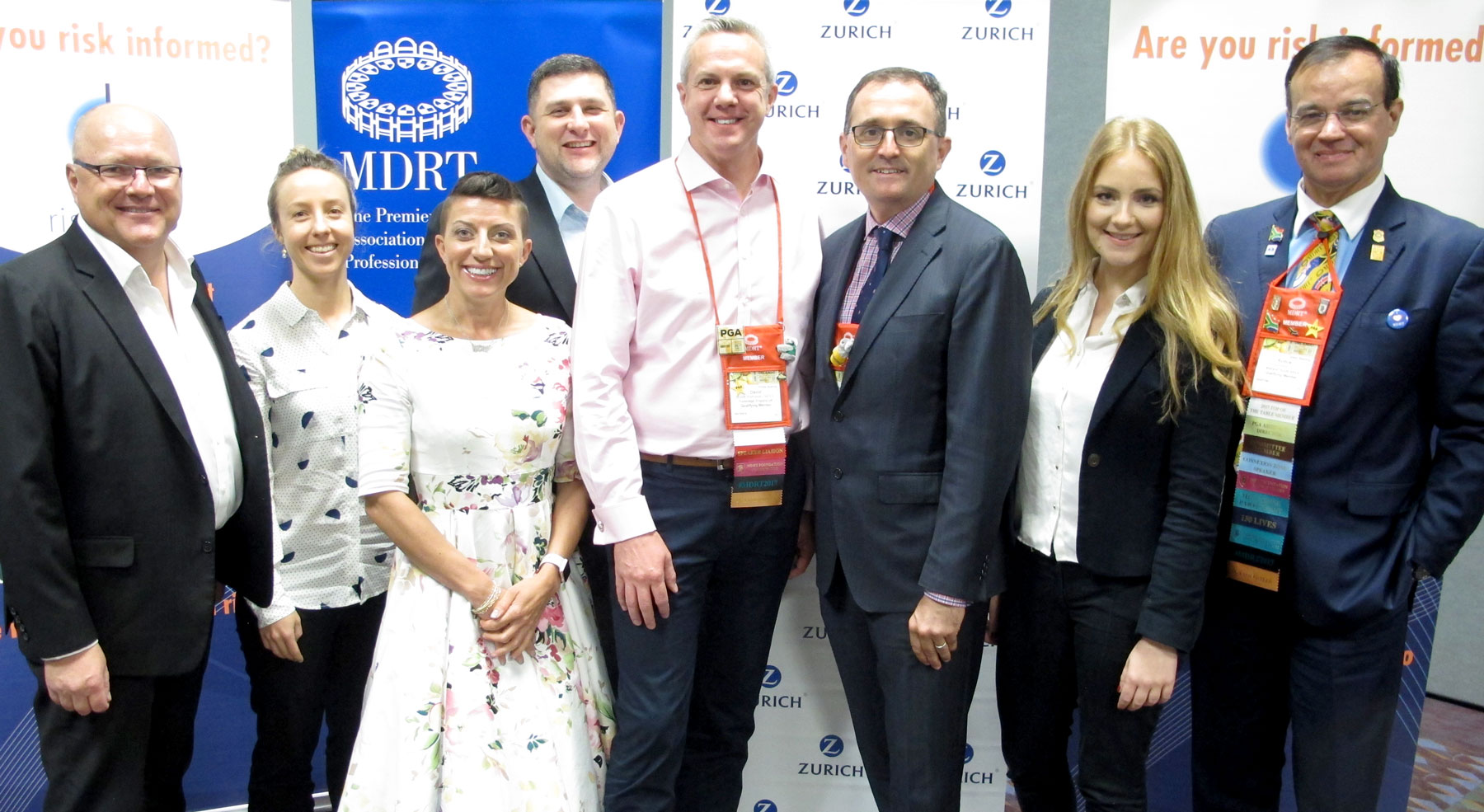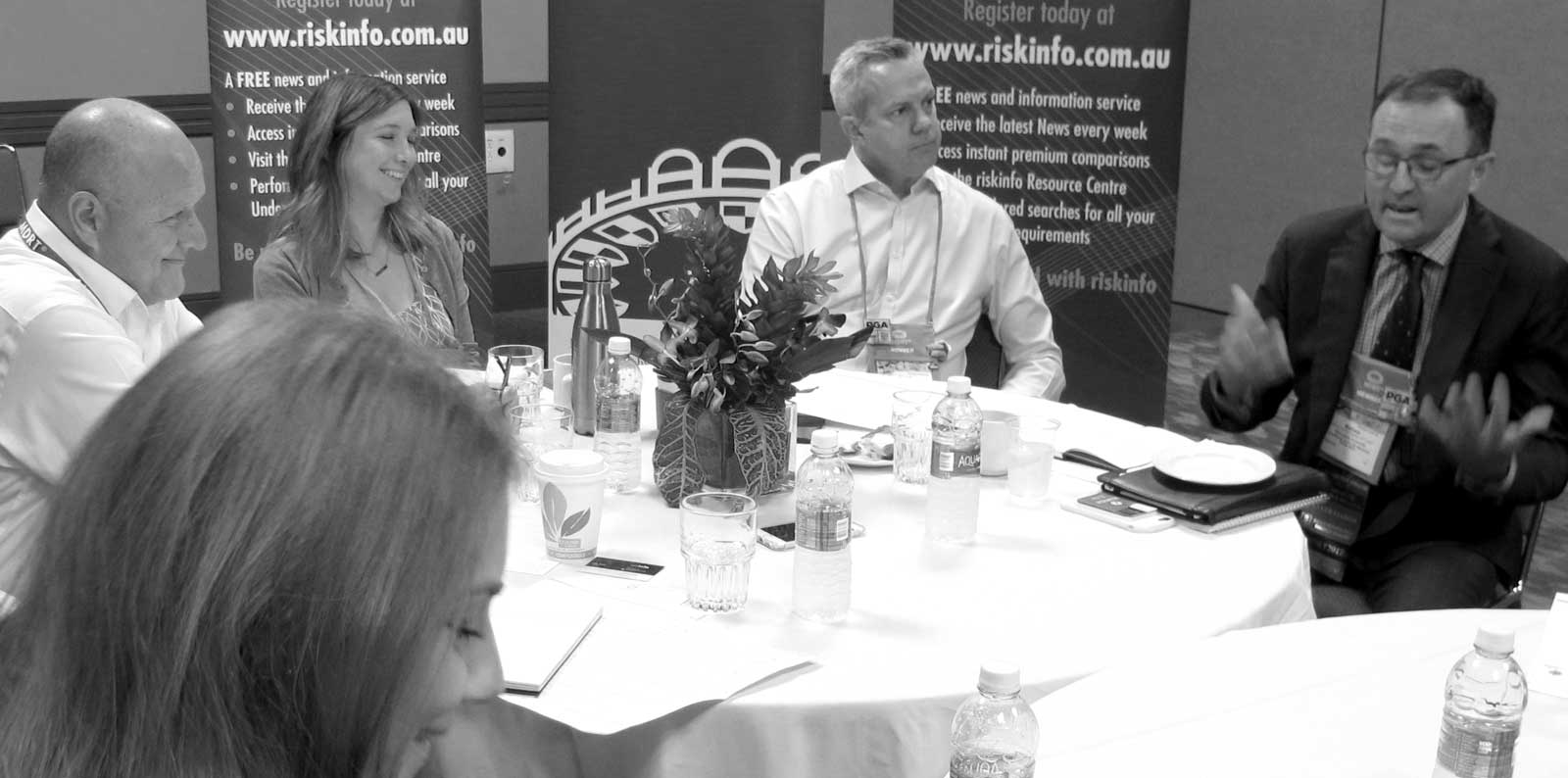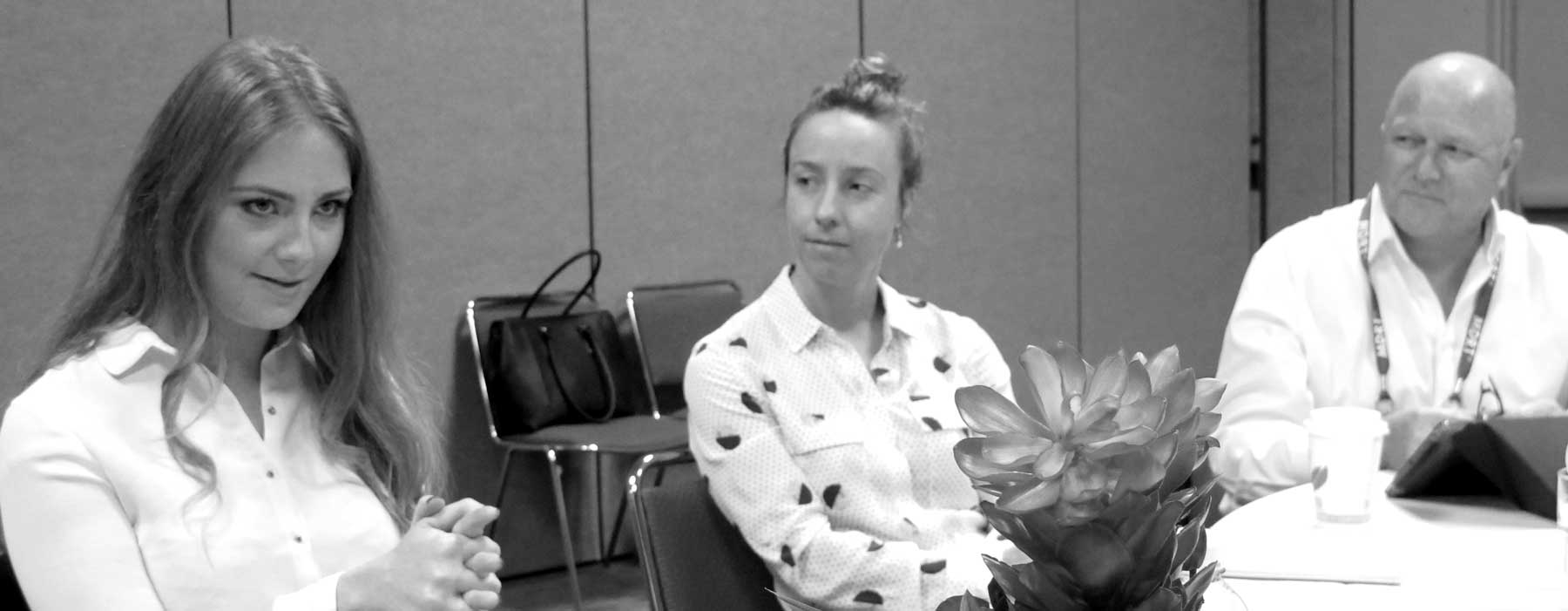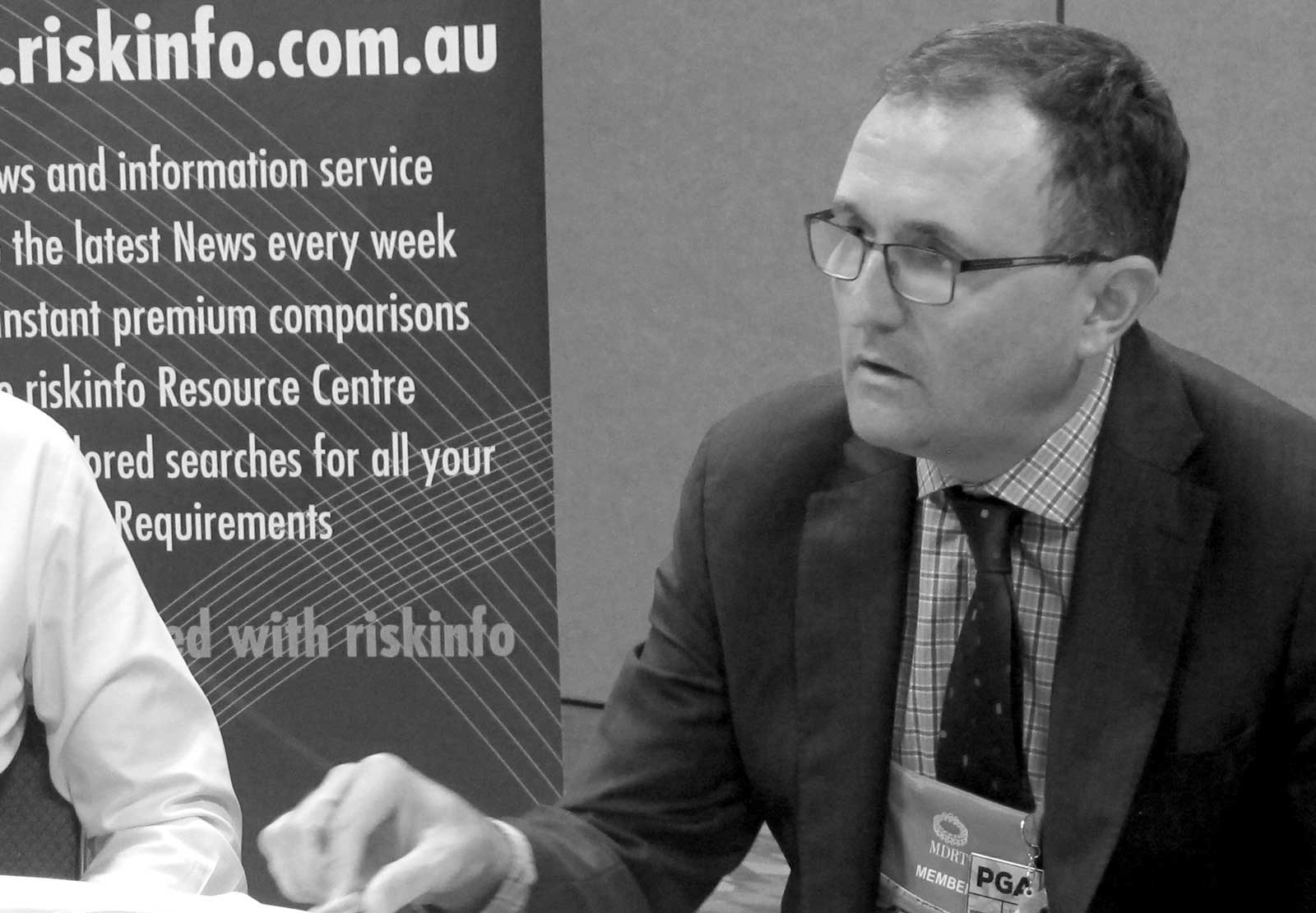Riskinfo joined forces with the MDRT organisation and Zurich in an International Adviser Round Table discussion on the changing nature of the ‘Value of Advice’ equation…
Part 2
Table of contents (Click these links to move directly to those topics)
- Perception of value in the mind of the client
- Scale and diversification
- Changing traditional mindsets?
- Final comments

Panelists (L – R)
- Peter Sobels – Publisher, Round Table Moderator
- Dominque Schuh – Australian MDRT adviser member
- Michelle Hoskin – Standards International, United Kingdom
- Ryan Pinney – US MDRT adviser member
- David Braithwaite – United Kingdom MDRT adviser member
- Mathew Fogarty – MDRT Oceania Chair, Co-host
- Jessica Brady – Zurich Financial Services Australia Senior Exec – Sponsor/supporter
- Kobus Kleyn – South Africa MDRT adviser member
We continue with Part II of our 2017 MDRT International Adviser Round Table where we asked advisers from around the world to reflect on the potentially changing nature of the ‘Value of Advice’ equation:
Part 2
Perception of value in the mind of the client – Back to top
The panel was asked to now consider the perception of value, taking another quote from the 2016 article written by Kobus as a starting point:
“It, goes without saying that if your clients perceive value in your advice offering it will be much easier for you to charge for said advice.”
He continued, “The difficulty that many financial advisers have is in communicating the value in what is essentially an intangible product, advice.”
We also read the panel a statement made by risk specialist adviser and consultant, Chris Unwin:
“I’ve found that many risk advisers are struggling with the concept of charging a fee for risk advice”.
And:
“More often than not, this will be because the value that a risk adviser represents to their client is not as tangible as the value that an investment adviser represents to their client. The monetary value of peace of mind is not as tangible for life insurance as it is in investment returns.”

Following these statements, we asked the panellists:
‘How does the consumer come to perceive the value that’s inherent in life insurance advice?’
Kobus: “You need to create the link with storytelling – so that the client can believe it can happen to anyone in their family. Until you’re able to paint the picture through storytelling, through ‘real life happens’ moments which clients can relate to, you’re not going to get these perceptions become reality in the clients mind.
Ryan responded to the challenge of this question by suggesting it needed to be considered relative to three different consumer demographics, being:
- Mom and Pop middle. “Pick your country – America, Australia, UK, New Zealand – it doesn’t matter. They’re the segment where the risk-based products are far and away more important than any other product that they can own and they’re usually the most underinsured population segment for life insurance.
- Business owners who need it for business succession, business continuation planning, etc
- High net worth individuals who are using it for tax leveraging strategies or for wealth creation or transferring welfares.
The problem, according to Ryan, is, that “…it’s really hard to make any money and stay in business if you focus on the most needy [mom and pop] segment.”
Scale and diversification – Back to top
He continued, “The industry tends to focus on the other two segments: business owners and those who are wealthy, and so the challenge has become how do you even have a conversation with someone who is going to struggle to pay for the premiums of the life policy and to whom you also need to provide advice? Ryan questions whether a fee-only strategy would work and suggests the merits associated with a combined fee and commission-based remuneration strategy, depending on the product segment, needs to be communicated more effectively to regulators.
Ryan continued, “We have one whole division that’s focussed on comparison shopping and speed of receiving the coverage. In some cases we can underwrite and insure somebody in the US in 15 minutes. I can have a policy to you completed, approved, and ready to go in 15 minutes or less and still have an adviser talk to you on the phone during that time period, asking you the questions – so it changes the conversation. If I couldn’t do that at scale, though, it wouldn’t be profitable, because I couldn’t afford the technology. I couldn’t afford the staff. I couldn’t afford the support personnel.
If I couldn’t do that at scale it wouldn’t be profitable
Following Ryan’s comments on scale of advice, Dom was asked how her clients see that her advice is delivering value and whether she was contemplating different or scaled ways of delivering different value in future:
“When I first entered the business I thought I’m going to set up a financial planning business talking about investments. I’m not even going to touch insurance. And it was on the end of the GFC (so, like worst business decision ever!) and so I went into advising on life insurance and eventually changed my business to be able to adapt to meeting those different needs. And I’ve just continued to do that – to move more into the holistic advice space.”
Dom said she would consider expanding her service proposition to potentially include complementary services such as lifestyle coaching or structuring fee-based SoA or claims services: “I wouldn’t say no to them but I’m not looking at it right now.” But Dom added that she does have crossover opportunities in her business with accounting and mortgage broking services, “…so we’re able to tell our clients we can do everything here. ‘Apart from a few little bits and pieces we can pretty much look after your financial house here’, so that is quite a valuable thing for some people,” said Dom.
From the UK adviser perspective David’s business offers comprehensive advice services: “We do the whole thing, so we’ve got investments and life insurance. The biggest difference I think between those two things is that when you’re setting up an investment or a pension for somebody, it’s something they already have and we’re just going to make it better, whereas when you’re buying insurance you’re asking them to part with money for something they don’t want to buy because people don’t want to face their own mortality,” he said.
“They can see investment planning and can touch it, compared with paying a premium for something that they never want to use. You’re asking them to buy something they never want to use and that is the hard conversation to have with them and often it does take life events such as bombings or from clients who have just had a first baby. And often they will come to us for advice because they don’t know quite what to do or how much they need.”
So it’s incredibly valuable what we do when we walk these people through this and set up these policies correctly – the right sum assured, the right terms, ensuring that it works and then going above and beyond. We have loads of claims. We just paid out somebody last week and – for a critical illness so you go through that and then you realised yourself the value of advice.
Changing traditional mindsets? – Back to top
“But here’s an interesting concept as well: we think that perhaps clients won’t pay for our advice, but I’m just sitting here thinking I’ve never asked anyone to pay for it. I’ve never asked them to pay me. So it’d be quite interesting.”
As a possible starting point, David projected this scenario: “‘Well actually, we’re going to charge you a fee to set up that structure and it includes this, but we’ve also gone and set up a trust and a will as well, so that we add the value there’. So if someone buys a policy we can wrap it up in a trust and we charge for that and that’s become normal. So why shouldn’t we be charging for the other bit?”
the large majority of the problems around the value of risk advice are in the advisers’ heads, not the clients’ heads
David’s comment led into another quote for the panel from Chris Unwin, in which Chris states:
“I believe that the large majority of the problems around the value of risk advice are in the advisers’ heads, not the clients’ heads. You are almost certainly already giving value; therefore any changes needed will be in your mindset, not your process.”
We asked Mat if he could ever see the value provided by a financial adviser being placed on the same pedestal in the mind of the consumer as they place the value of the advice they receive from other professionals, such as doctors, lawyers and accountants.
“With the professional standards increasing, yes – the minute the commissions are taken out,” said Mat, who suggested a move to charging fees for risk advice may take at least a generation to come to fruition.

“It’s probably going to take a bit of time. Professional standards are going to go up, there is – the commoditisation of products that’s happening and I think people who are still holding onto getting paid a commission in the future world may be disappointed.
“Will it happen in the risk business? Absolutely, I have no question about that in my mind.”
Kobus: “I believe that we are on the way to transforming into a fully-fledged professional industry and a profession and especially within the long term assurance and investment sectors of our industry. We will …transform from an industry to a profession because if you look at the definitions, an industry is simply a manufacturing facility producing products or policies, in the case of our current industry. A profession is much more profound in nature and comprises a disciplined group of professionals who operate under a code of conduct and strong ethical standards. Such a group positions itself as possessing special knowledge and skills under a recognised professional body with continuous professional development, and is recognised by the public as professionals they are willing to pay for their services. These professionals are prepared to apply their knowledge and skills in the interest of others first and foremost. It includes a formal qualification and designation.
We asked Ryan whether he could possibly imagine his business set up charging fees rather than being remunerated by commission:
Ryan: “Yes and no. It’d be a difficult transition. I would love to have a product that was 100% commission, and then an option for me to take zero per cent or some number other than that because then I … could compete against somebody who is charging full commission and say to the client, ‘You can see that the reason that their product’s 15% or 20% more expensive [than our offer] is because of the commission.
Dom: Would your business be able to survive and prosper if all life insurance commissions were banned?
“It would now,” she said, “…but only because I’ve differentiated into other areas of advice.”
So what would happen for the risk-focussed advice?
“I think you’d have to have scale, big scale in Australia, to be able to do that,” she cautioned.
there are some necessary endings that need to be had across the profession and industry as a whole before we become a new breed of planner.
Michelle agreed that part of the issue relating to the perception of the value of life insurance advice is “…all in our heads. I would never question the value of my advice – ever, because I’m being paid by the person that’s receiving my advice. If [all] commissions were banned and you couldn’t take a single penny from anywhere other than the client we’d be having a whole different conversation around the table. Ryan would have a different business model but he’d make it work – of course he would. So I think we’re trying – I think there are some necessary endings that need to be had across the profession and industry as a whole before we become a new breed of planner.”
Jessica: “I think the challenge may be that, as an insurer we deal with people who have businesses not unlike Ryan’s and then we have people who are not unlike Mat. This has become quite an emotive discussion in Australia [regulation, compliance, journey to ‘professionalism’].
Change is coming; some of it may be daunting and whether or not those changes meet their ultimate goal – that is, better advice outcomes for consumers – only the future can tell. Despite how extended the discussion has been, I think there’s a varying level of readiness amongst the adviser populace for the change. Significant regulation changes come into place in January 2018 and yet when I ask risk-focussed businesses about their strategy and their plan and what modelling they’ve done, amongst some, there’s been very little.”
She continued, “I’m not convinced that everyone who is risk-focussed truly understands the mechanics of it – and because these regulations cover how people are remunerated in future, that’s a huge concern.”
Jessica said she and her colleagues were optimistic about risk advice “…and we want people to be fairly remunerated. But I think a lot more thought and consideration needs to be given, particularly by those who are risk advisers, around the feasibly of how this will work in the future and around really understanding how the numbers for their own business will unfold.”
Final comments – Back to top
Having run out of time (as usual!) our panellists were invited to make final comments/observations on any issues that were under discussion or on the question of how they would solve the underinsurance crisis in their country:
Dominique Schuh: “With the underinsurance issue, there’s a cost to paying for insurance but there’s also a broader cost to the community and the government and the taxpayer to support individuals and families who don’t receive claim benefits. So I would be interested in a solution on a national scale in Australia, and maybe around the world, based on the fact that consumers often respond well to incentives.
“We’re financially incentivised to take out private health insurance in Australia, so perhaps that would be a way to work nationally for life insurance as well.”
David Braithwaite “Before we start trying to create client value we’ve got to value ourselves. We make a dramatic difference in people’s lives because of what we do and how we deliver our services. But also don’t assume we know what the client’s thinking in terms of whether we were to charge them a fee. If we haven’t asked them to pay a fee, how do we know they won’t? At the moment, we’re making assumptions based on old habits. And I think there’s a potential here as well to package the risk product into a wider chargeable solution. So you package it up and you create something that is worth valuing by the client.
“And it’s not just one solution. It’s a multiple solution to different issues and part of that package includes the risk component.”

Mathew Fogarty: Mat was on the same wavelength as Dom when it comes to addressing the underinsurance crisis: “People generally don’t want to take responsibility for themselves. You need to give consumers some sort of incentive. You know the Government uses a stick to incentivise people to take out private health insurance in Australia, and some people respond to the stick. But some people also respond to the carrot.”
Kobus Kleyn: “I want to go on to what these two guys are saying that makes so much sense. I refer to underinsurance. It’s a global problem; it’s a country problem; it’s an individual client’s problem and because they’re our clients, it’s our problem, too. It means we’re not doing our job because if you’re really building your brand and your financial planning and your package you should be doing holistic financial planning …and that means every year you review your clients financial plans and risk concerns and ensure there are the least possible gaps or shortfalls or, as I like to refer to it, ‘opportunities to enhance your risk (protection) profile’.
there are some necessary endings that need to be had across the profession and industry as a whole before we become a new breed of planner.
“I don’t think there’s always an issue with professional planners like us on this panel, but there are country and global-level underinsurance issues due mostly to the lack of awareness in the community. It comes down to all of us using the power of social and other media with the help and support of our professional consumer bodies, our professional and industry affiliations and our financial planning bodies to keep on driving significant consumer awareness around financial planning and the value-add of financial planning and risk planning. The rest will surely follow as a consequence of awareness and education.
“Awareness of risk insurance through social media is what should be the driving factor and differentiator. So I think this whole underinsurance or gap-insurance problem is a global phenomenon, but it starts with all of us to close the gap on underinsurance. By building our professional brand – by building a profession out there, if we do that through social media and get it out there, the consumer will believe that when they buy this product they’re actually buying a solution.”
Ryan Pinney: “I’m going to steal a line from my friend Van Miller and say this is the greatest time in the history of mankind to be a professional financial adviser or insurance agent and personally I’m glad for all the turmoil and I’m actually glad for MDRT because I get to see what’s happening around the globe and I get see what the response has been from Australia and England and New Zealand and South Africa in dealing with some of the same issues that we’re starting to see ourselves. And I have a pretty clear roadmap of where I want to go and what I need to do to keep my business successful. And I’ll tell you now I think that the biggest advantage I have … is technology.
“So, if you’re looking to expand your business and get scale today you’re probably looking for – for lack of a better term – a CTO (Chief technology Officer) and maybe a CMO, Chief Marketing Officer, who can utilise social media, who can utilise email and set up e-commerce and things like that because really we all have clienteles who want to interact in a very hands-off virtual environment – low touch, and it would not be difficult to charge those people a fee who require those services if you have the technology to support it.”
Michelle Hoskin: “In the UK it’s illegal if you have a dog and don’t chip it, right? Which is crazy, right? It’s illegal to drive a car without car insurance, which is obvious. The only way we’re ever going to crack this [underinsurance] is if the Government makes it illegal to not have life insurance. But they wouldn’t do that because it has no benefit to them at all. They are incentivising you to have health insurance because it doesn’t cost them then. But I like the incentive idea. I think that’s bang on and I think the problem we’ve got in the UK is we have an amazing health service and we’re so lucky. We pay into it, but we don’t know we’ve been born half the time so our lives are taken care of by the Government. Our health is taken care of by the Government. If they stopped the health service I think you’d see more people insuring their lives.”
Jessica Brady: “I see advice moving to more of a coaching-style relationship and I think that is definitely coming through, particularly in the younger generation of advisers. They’re not interested necessarily in products as such – they’re much more interested in understanding the financial goals of the client and making sure the plans stack up to that.
“I also think Ryan’s point on technology’s a really interesting one. I think in Australia a lot of advisers have feared technology becoming a disrupter of their industry and their business and subsequently haven’t really invested enough. I think it’s actually been to their detriment because they haven’t necessarily looked at how they can utilise technology to create stronger relationships with clients.
“Specifically on the under-insurance problem ,the idea about deductibility is a really interesting one. The other one that’s been floated about was I know that in some European countries, you can’t take out a debt unless you take out equivalent insurance. I think that’s an interesting kind of concept, and in Australia, that only currently exists at a business level.
“So I think there is obviously a piece for the Government to really consider at a higher level, specifically in the insurance market. We have such a lot to do to change the perception of clients that this is not a ‘maybe have’, but rather it’s a ‘must have’. Within the Australian market I think we’ve got a lot of work to do to share the good claims stories. Bad news sells, and all we talk about is perhaps the ‘not-so-good’ stories. So I think we all have a part to play in sharing those great stories where we’ve been able to help clients with their insurance.
“We educate ourselves and we’re preaching to the converted here, but we’ve got a lot to do to get to that next level.”
